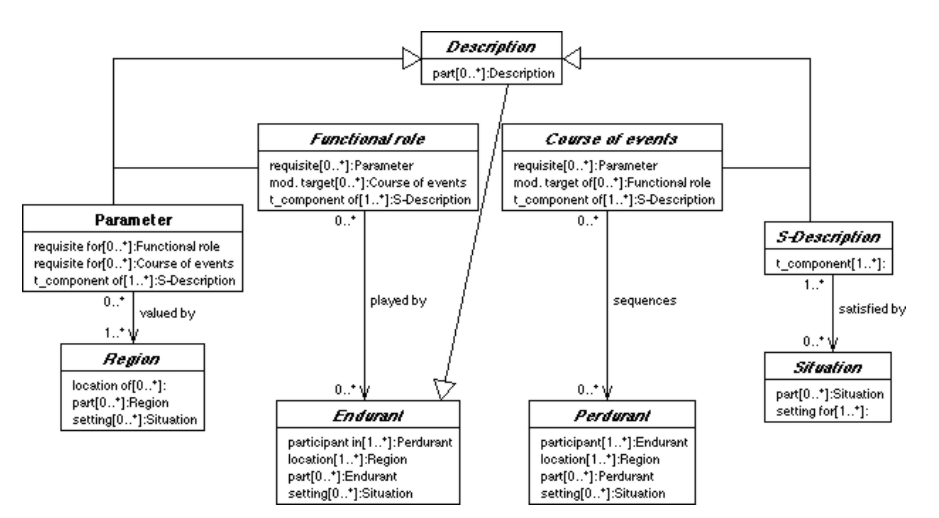Descriptions and Situations Ontology
The Descriptions and Situations (D&S) ontology pattern is a conceptual framework used in the Semantic Web for modeling and representing context and situational information. This ontology pattern enables the formalization of how descriptions (conceptualizations of situations) relate to the actual situations they describe. The D&S pattern is essential for applications that need to handle contextual information and varying interpretations of data. Here is an overview of the key components and concepts of the D&S ontology:

Features
- provides a formalization of frame semantics, generalizing over Fillmore’s [Fillmore and others, 2006] and Minsky’s [Minsky, 1974] proposals
- defines a general vocabulary for n-ary relations, introducing the concepts of description and situation
- A situation is a set of facts, as it is described by an observer, involving a set of entities.
- A description is a perspective (a theory, a schema) defining concepts that can classify, hence interpret, the entities observed in a situation
- both descriptions and situations are formalized as first-order entities in an ontology, therefore potentially enabling reasoning over them both at the intensional (description) and extensional (situation) level, in the same domain of discourse
Key Components of D&S Ontology
-
Description
- aka conceptualization, representation, schema, or function
- Definition: A conceptualization that defines a situation. It includes concepts, roles, and relationships that are expected in a situation.
- Example: A description of a "Meeting" might include roles like "Participant" and "Location" and relationships like "attends" and "held in".
-
Situation
- Definition: An actual instance or occurrence in the real world that satisfies a description. A situation is bound by the entities and relationships defined in the description.
- Example: An actual meeting where Alice and Bob participate in Room 101.
-
Entity
- Definition: Any object or individual that plays a role in a situation.
- Example: Alice, Bob, and Room 101 are entities in the situation.
-
Concept
- Definition: The abstract idea or category that entities belong to within a description.
- Example: The concept of a "Participant" in a meeting.
-
Role
- Definition: The function or part played by an entity in a situation, as defined by the description.
- Example: Alice and Bob playing the role of "Participants".
-
Relationship
- Definition: The connections or associations between entities in a situation, as specified in the description.
- Example: The "attends" relationship between "Participants" and the "Meeting".
-
Constraint
- Definition: Conditions or rules that must be met for a situation to satisfy a description.
- Example: A constraint that a meeting must have at least two participants.
Core Concepts and Axioms
-
Satisfies
- Definition: A situation satisfies a description if all the roles, entities, relationships, and constraints specified in the description are present and met in the situation.
- Example: The situation where Alice and Bob are in Room 101 satisfies the description of a "Meeting".
-
Classification
- Definition: Entities in a situation are classified according to the concepts defined in the description.
- Example: Alice and Bob are classified as "Participants".
-
Role Assignment
- Definition: Entities in a situation play specific roles as defined by the description.
- Example: Alice and Bob are assigned the role of "Participants" in the meeting.
-
Relationship Representation
- Definition: The relationships among entities in a situation correspond to the relationships defined in the description.
- Example: The "attends" relationship between Alice, Bob, and the meeting.
-
Constraint Satisfaction
- Definition: All constraints specified in the description must hold true in the situation.
- Example: The constraint of having at least two participants in the meeting is satisfied.
-
Temporal and Spatial Context
- Definition: Situations are bounded by the temporal and spatial contexts as described.
- Example: The meeting takes place at a specific time and location.
Use Cases
- Event Modeling: Representing events like meetings, conferences, or workshops where specific roles, entities, and relationships need to be defined and verified.
- Contextual Information: Capturing the context in which data was generated or used, which is crucial for accurate interpretation and decision-making.
- Complex Systems: Modeling complex systems where different components interact in various roles and relationships.
By using the D&S ontology pattern, one can create a robust framework for representing and reasoning about the contexts and situations in which data and entities are involved, enhancing the Semantic Web's capability to handle complex and contextual information.
References
Backlinks